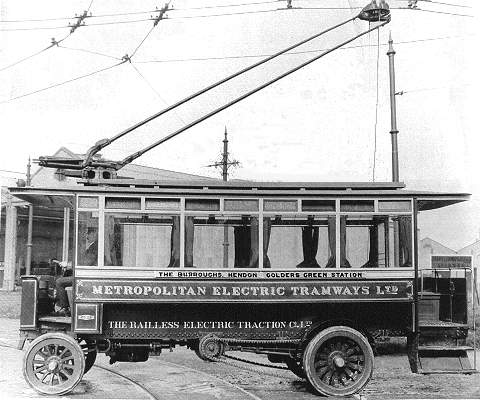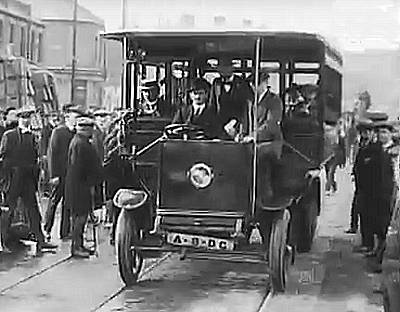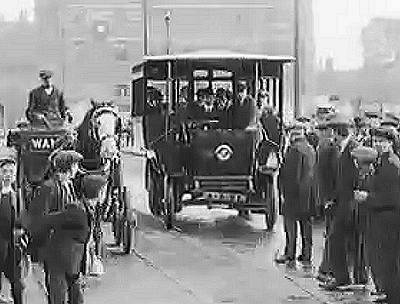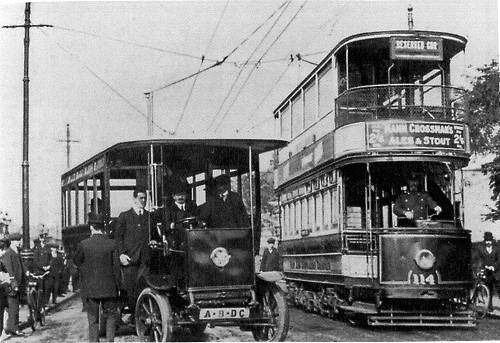
|
West Ham's First Trolleybus
By John Prentice Part 1 |
Most Londoners think of trolleybuses beginning in London in 1931 as tram replacements. True for full public service, but the first trolleybus to run with passengers on a London street was nineteen years before. A little earlier still in 1909 a Railless Electric Traction (RET) vehicle, the first trolleybus in Britain, was tested by the Metropolitan Electric Tramways (MET) and was shown to the annual conference of the Municipal Tramways Association. It used a British redesign by Edward May Munro of the overhead system of Max Schiemann of Wurzen, Saxony (similar to two tramway trolley poles, but in this particular case with a single head). However, this trial was entirely within the confines of Hendon Depot yard, not on a public road. It was in September 1912 that an Austrian Cedes-Stoll trolleybus was run by West Ham Corporation carrying passengers on a London public highway, Greengate Street.
(Throughout this article the word "trolleybus" has been used, but to be strictly correct the name "railless or trackless trolley car" was used in 1912, "trolleybus" not coming into common use until the 1920s).

Britain's first trolleybus was this Railless Electric Traction car with chassis by James and Browne of Hammersmith, London, two BTH 25 h.p. motors with chain drive, a BTH B18 tram controller below the driver's seat and 24-seat body by G.C. Milnes Voss & Co. of Birkenhead. It used the German "Schiemann" overhead system, redesigned and patented (jointly with RET) by Edward May Munro, formerly the engineer of Brecknell, Munro and Rogers Ltd. It was demonstrated within the confines of Metropolitan Electric Tramways' Hendon Depot in September and October 1909.
The 1912 annual conference of the Municipal Tramways Association was hosted by West Ham Corporation Tramways and its manager, Herbert Edwin Blain, on 25th to 27th September of that year. Throughout the three days, presentations, meetings and discussions took place. Inside the tramway's Greengate Street Depot workshops was an exhibition, claimed by an expert at the time to be the most important of its kind since that at London's Agricultural Hall in 1885, with stands by many of the tramway manufacturers of the day showing their latest products. Among these was one by British Radial Axle Cars Ltd., using a 1in. to 1ft. scale working model tram truck on a track with two reverse curves, to demonstrate the Barber three axle system. (see Three Axle Tramcars.)
 But it was outside in Greengate Street itself that a most significant event was taking place. The Clough, Smith company (formed by Norman Clough and Sidney G. Smith - an ex MET employee, who had supplied the overhead for the Hendon trial, they later went on to do so elsewhere and to market trolleybuses themselves) had erected a single line of trolleybus wires of 0.348" gauge (i.e. 2/0 S.W.G.) in the centre of the road between the tramway overhead, suspended from the span wires by curved "J" hangers. The test section ran for some 400 yards and since Greengate Street itself is only a quarter of a mile long, the line must have run from close to Plaistow Broadway in the north to close to the junction with Barking Road at the Greengate pub in the south.
But it was outside in Greengate Street itself that a most significant event was taking place. The Clough, Smith company (formed by Norman Clough and Sidney G. Smith - an ex MET employee, who had supplied the overhead for the Hendon trial, they later went on to do so elsewhere and to market trolleybuses themselves) had erected a single line of trolleybus wires of 0.348" gauge (i.e. 2/0 S.W.G.) in the centre of the road between the tramway overhead, suspended from the span wires by curved "J" hangers. The test section ran for some 400 yards and since Greengate Street itself is only a quarter of a mile long, the line must have run from close to Plaistow Broadway in the north to close to the junction with Barking Road at the Greengate pub in the south.
 On this line a Cedes-Stoll trolleybus, supplied by UK agents Trackless Trolley Limited, was available for passenger rides by town councillors, tramway managers, conference delegates and their families throughout the conference period. Reports are that the running was exceptionally smooth and quiet. It has been suggested, but not confirmed, that for a small charge members of the public may also have been allowed to sample the vehicle.
On this line a Cedes-Stoll trolleybus, supplied by UK agents Trackless Trolley Limited, was available for passenger rides by town councillors, tramway managers, conference delegates and their families throughout the conference period. Reports are that the running was exceptionally smooth and quiet. It has been suggested, but not confirmed, that for a small charge members of the public may also have been allowed to sample the vehicle.
The two unique features of the Cedes-Stoll trolleybus were its over-running overhead trolley pickup and its wheel hub motors, as we will now see.

A posed view in Greengate Street in September 1912 shows the Cedes-Stoll trolleybus passing "Reserved Car" 114. At the time this was one of West Ham's newest trams, their first bogie cars, which were built by Hurst Nelson in 1911, having L.C.C. standard class 4 maximum traction bogies. The photograph was published in Tramway & Railway World in 1912 and was later used in the same magazine in advertisements for Cedes Electric Traction Ltd.
There is a British Movietone News film clip of the West Ham demonstration. Click here.
![]() Go now to Part 2
Go now to Part 2
![]() Return to Historic Tramways
Return to Historic Tramways